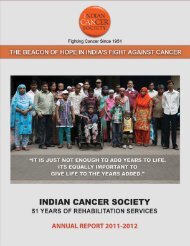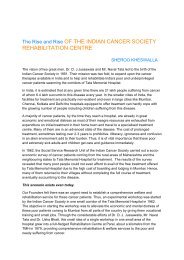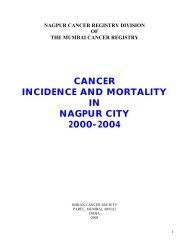Mumbai Cancer Registry - Update - Indian Cancer Society
Mumbai Cancer Registry - Update - Indian Cancer Society
Mumbai Cancer Registry - Update - Indian Cancer Society
Create successful ePaper yourself
Turn your PDF publications into a flip-book with our unique Google optimized e-Paper software.
MUMBAI CANCER REGISTRY – UPDATE<br />
By Dr. B.B. Yeole (Director) <strong>Mumbai</strong> <strong>Cancer</strong> <strong>Registry</strong>, <strong>Indian</strong> <strong>Cancer</strong> <strong>Society</strong> &<br />
Dr. A.P. Kurkure, Hon. Secretary & Managing Trustee, <strong>Indian</strong> <strong>Cancer</strong> <strong>Society</strong><br />
History: The <strong>Mumbai</strong> <strong>Cancer</strong> <strong>Registry</strong> was established in June 1963 as a Unit of<br />
<strong>Indian</strong> <strong>Cancer</strong> <strong>Society</strong> with the aim of obtaining reliable incidence & mortality on<br />
cancer from a precisely defined urban population. Compilation of the data began in<br />
1964. Until then, no continuing activity on registration of cancer cases in a population<br />
had been undertaken in India. The registry started in collaboration with and upto<br />
1975 received financial from Biometry branch of the US National <strong>Cancer</strong> Institute.<br />
During 1976-80 the registry received financial support from the Department of<br />
Science Technology, of the Government of India and <strong>Indian</strong> <strong>Cancer</strong> <strong>Society</strong>. Since<br />
1981-82, the registry has been funded in part by the <strong>Indian</strong> Council of Medical<br />
Research.<br />
Registration Area: The <strong>Mumbai</strong> <strong>Registry</strong> covers the residence population of Greater<br />
<strong>Mumbai</strong>, a densely – populated metropolis on the west coast of India occupy an area<br />
of 437.7 Km² between latitudes 18-19⁰N and longitude 70-71⁰E. Greater <strong>Mumbai</strong> is<br />
in fact an Island joined to the mainland by bridges, and has a warm, humid climate.<br />
The population of Greater <strong>Mumbai</strong> as per 2001 census was 11.9 million with a sex<br />
ratio of 811 females per 1000 males. It has a density of 2770 inhabitants per km²,<br />
making it the most populated district in the country. The decennial growth rates of<br />
the population between 1991 and 2001 were in the order of 20.2. The literacy rate<br />
was found to be 87%.<br />
The city is the Industrial heart of India. As result of continuing immigration it has multi<br />
religious and multilingual population representing every state in the Union,<br />
approximately 67.4% being Hindus, 18.6% Muslims, 3.7% Christians, 5.2% Neo-<br />
Buddhists, 3.7% Jains & 0.5% Parsis.<br />
<strong>Cancer</strong> Care Facilities: Municipal Corporation and State Government maintain the<br />
majority of hospitals in <strong>Mumbai</strong> and the major source of the data is the Tata<br />
Memorial Centre, which is postgraduate university teaching centre for cancer<br />
research. The city has 7 medical colleges. The diagnosis and treatment of cancer is<br />
centralized in certain hospitals. Major cancer surgery is undertaken in all the major<br />
hospitals and well-equipped private nursing homes. Facilities of cobalt-60 are<br />
available in 10 hospitals while ulto-voltage deep x-ray therapy is available in 15<br />
hospitals.<br />
A total of about 35,000 hospital beds are available in the registration area. There<br />
have been improvements in diagnostic facilities, as new hospitals have immerged<br />
with histopathology and imaging facilities in registration area.
Methodology: Staff members of the registry visit the Ward of all co-operative<br />
hospitals at least weekly to personally interview each cancer patient. All files<br />
maintained by the various departments of these hospitals are crossed checked<br />
individually. Care is taken to prevent duplication of an entry relating to a patient<br />
already registered supplementary information is gleaned the death records<br />
maintained by the Municipal Corporation.<br />
Findings: for the past 45 years the registry has collected all essential data<br />
pertaining to cancer patients in the residence population of Greater <strong>Mumbai</strong>. Data<br />
collected so far has been fully analysed. During the period 1964-2006 a total of<br />
2,60,000 cancer cases has been registered and 1,35,000 cancer deaths were<br />
detected among the residence population of <strong>Mumbai</strong>.<br />
In 2006 in Greater <strong>Mumbai</strong> 11033 (5358 males, 5683 females) new cancer cases<br />
were found to have been registered. The crude incidence rate per 1000 population<br />
for females (96.2) was found to be higher than for males (72.9). In males the lung as<br />
a single organ was found to be vulnerable to cancer followed by prostate,<br />
lymphomas, liver and larynx in descending order. In females, the breast ranked first<br />
followed by the cervix, ovary, lung and leukemias in that order.<br />
<strong>Cancer</strong> occur mostly at older ages, as only 2.3% of the total number of cancer cases<br />
registered were under 15 years of age, although this age group accounts for 24.9%<br />
of the total population. The association of cancer with the ageing process is clearly<br />
shown by the fact that 33.5% of the cases were diagnosed in those aged 65 and<br />
above, and age group which comprises only 4.6% of the population.<br />
<strong>Cancer</strong> incidence rates were found to increase sharply with age. The curves for men<br />
and women however were quite distinct. At younger ages the incidence rates were<br />
found to be higher in males. Age specific incidence rates were higher in females only<br />
between the ages 20-64. Frequent occurrence of cancers in involving female genital<br />
organs and the breast accounts for these difference.<br />
The Parsi population appears to be higher risk than those professing other religions.<br />
The rates for Parsis are about two times of that in other religions. On the cumulative<br />
incidence rate basis on an average 1 out of 9 males and 1 out of 8 in females gets<br />
cancer in his/her life time. In males 1 in 84 will get lung cancer and females 1 in 28<br />
will get breast cancer. Education level shows a very interesting gradient with respect<br />
to the occurrence of cancer. <strong>Cancer</strong> of the head & neck and cervix were found to be<br />
prevalent at the lower educational level and incidence starts to decrease as the<br />
education level increases. The exact reverse situation is observed for cancer of the<br />
breast.<br />
Trends: For the period 1982 to 2006, the overall age adjusted cancer incidence rates<br />
for all sites together are seen to decrease 0.81 per year in males and 0.25 per year
in females. Increasing trends in incidence are seen in males for cancers in involving<br />
the liver, gallbladder, prostate, kidney, brain, lymphomas & leukemias and in females<br />
for cancers involving the gallbladder, breast, uterus, ovary, kidney, lymphomas,<br />
leukemias & multiple myelomas. A decreasing trend in incidence was found for the<br />
tongue, oropharynx, hypopharynx, esophagus, stomach larynx, testis & penis in<br />
males and tongue, mouth, oropharynx, hypopharynx, esophagus, stomach, larynx<br />
and cervix in females. The incidence was found to be more stable for cancers<br />
involving colon, rectum, pancreas, urinary bladder & thyroid in males and colon,<br />
rectum, liver, pancreas, urinary bladder & thyroid in females.<br />
Survival: In order to describe completely the experience of cancer in a population it<br />
is necessary to know not only incidence & mortality but also the survival of cancer<br />
patients. Based on 1992-1999 data from <strong>Mumbai</strong> <strong>Cancer</strong> <strong>Registry</strong> the relative 5 year<br />
survival proportions are for head & neck cancer 38.58%, colon-rectal cancer 39.4%,<br />
larynx 38.2%, esophagus 11.8%, stomach 10.1%, pancreas 4.1%, lung 7%, breast<br />
54% and cervix 46%.<br />
Utility: The <strong>Mumbai</strong> <strong>Cancer</strong> <strong>Registry</strong> data have been used by Central Government<br />
of India and State Government of Maharashtra for their cancer control programme.<br />
Various hospital authorities used these data for establishing priorities for<br />
hospitalization and adequate treatments. Many scientists used this data for<br />
undertaking epidemiological studies in order to establish disease related risk factors.<br />
Various hospitals in <strong>Mumbai</strong> have used these registry’s data to improve the<br />
diagnosis, treatment and survival rate of their patients through the creation of tumor<br />
clinics and inter-departmental conferences. They have raised the level of training in<br />
cancer of medical and auxiliary personnel.<br />
Publications: This registry’s data has been accepted for publication in VII Volumes of<br />
<strong>Cancer</strong> Incidence in five continents, II Volumes of International Incidence of<br />
Childhood cancers and in both the Volumes of cancer survival in developing<br />
countries. All these publications are from IARC-WHO. Upto now registry published<br />
more than 110 research articles in International & National Journals and also<br />
published 50 Monographs on cancer incidence and mortality, survival & trends.<br />
Estimated Incidences (New Cases) and Deaths – India 2000-2008<br />
Site 2000 2008<br />
Male Female Male Female<br />
Incidenc<br />
e<br />
Death<br />
s<br />
Incidenc<br />
e<br />
Death<br />
s<br />
Incidenc<br />
e<br />
Death<br />
s<br />
Incidenc<br />
e<br />
Death<br />
s<br />
Oral 49632 29054 29364 17222 56134 33539 33358 19564<br />
Cavity<br />
Pharyn 38985 28240 8520 6042 43066 31190 9281 6580
x<br />
Larynx 23104 14465 2999 1826 26385 16519 3497 2129<br />
Lung 33880 31520 7644 7079 38318 35649 9027 8360<br />
Breast 79124 40607 102782 52750<br />
Cervix 125952 70528 142580 79838<br />
Uterus 6595 2045 9028 2800<br />
Ovary 20170 11910 24809 14649






